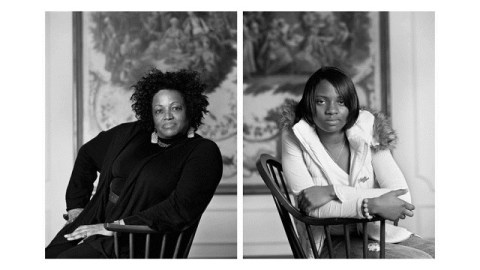What Does/Should/Can the 2014 Whitney Biennial Mean?

Every two years the American contemporary art world converges on The Whitney Museum in New York City. And biennially the Whitney Biennial inspires the whole gamut of critical reactions from overwrought praise to gender- and/or race-based outrage to stifled yawns of indifference. The Whitney Biennial 2014, which follows the trend begun back in 1932, when Gertrude Vanderbilt Whitney launched what is now the 77th annual or biennial carrying her name, follows the recent pattern of outrage and indifference, but unadulterated praise seems hard to find. Considering just how much attention is paid to the Whitney Biennial, shouldn’t we ask why we pay attention? If we’re not happy with what the Whitney Biennial means now, what should or even can we expect it to mean in the future?
The outrage is easy. Actually, it’s so easy that you wonder why the curators didn’t anticipate it. Jillian Steinhauer at Hyperallergic collected all the sad statistics in one place. Only 38 of the 118 participants (Steinhauer’s count, which is larger than the Whitney’s own tally of 103) are women, which amounts to 32%—actually a decrease from the percentage in the last Biennial in 2012. (That gender discrepancy inspired a one-day, all-female, counter-exhibition, comically titled Whitney Houston Biennial.) Only 9 of the 118 participants are African-Americans, making for an even paltrier percentage of 7.6%. (Just to make that stat sadder, consider that one of those 9 African-American artists, “Donelle Woolford,” is a female artist character created by white male artist Joe Scanlon.) As Steinhauer also points out, Donna De Salvo, Chief Curator and Deputy Director for Programs at the Whitney, promises in press notices that the 2014 Biennial will “offer one of the broadest and most diverse takes on art in the United States that the Whitney has offered in many years,” but shamefully fails to deliver. In 2014, is it too much to ask that a survey of American contemporary art look roughly like the people of America?
Linked to these issues of gender and racial politics are a near absence of any politics at all. Again, Steinhauer’s on the job taking the Whitney Biennial to task for nearly ignoring all contemporary American politics in its choice of artworks to feature. Damning with faint praise, Steinhauer calls “the biennial… overly neat and likeable, scarcely messy or funny or challenging,” which doesn’t make it a disaster, but doesn’t make it a success, either. “All art need not be political, but a show that disregards politics in the United States in 2014 is a delusion,” Steinhauer holds, “not simply because of the state of the country and the world, but also because of the state of art itself.” Yes, the mainstream art world has taken great strides in incorporating previously marginalized groups, but, as Steinhauer points out, that inclusion happens “often still in a segregated way, which many of them question.” So much art today originates from the political tensions that come from gender and racial politics, yet the 2014 Biennial for the most part shies away from those tensions, which results in an often lifeless show.
Steinhauer offers Dawoud Bey’s photographs from The Birmingham Project (including Maxine Adams and Amelia Maxwell, from 2012; shown above) as the rare exception that demonstrates what could have been for the Biennial. Bey studied the case of the 1963 racially motivated Birmingham church bombing and used his findings to photograph a set of diptychs showing a young African-American boy or girl at the age of those killed in the bombing or subsequent shooting paired with an adult African-American man or woman the same age that the victim would have been had they lived. Bey’s deceptively simple concept makes a powerful political statement without preaching, which is exactly the kind of political art that all museums, but especially during high profile events such as biennials, should promote to foster critical thinking rather than simplistic demagoguery.
The only offense possibly worse than political blindness, however, might be narcissistic blandness. Jerry Salz believes there’s “a smart show struggling to get out of this big, bland Whitney Biennial,” but it sounds like a losing battle. Aside from some paintings, sculptures, and other crafts found on the floor curated by artist Michelle Grabner, Salz sees only an “optically starved, aesthetically buttoned-up, pedantic biennial… a nebulous tasting-menu mess that exudes an inert elegiac air.” For Salz, the biggest problem for the Biennial is that, instead of presenting art asking to be read, it presents readings masquerading as art in “an extension of our highly educated class of artists and curators, an urge to ape the look of art, play by the rules, and be accepted by institutions.” Too much of the art has been chosen because “it checks all the boxes: It takes up a lot of space, is momentarily engaging, has video, references film, and comes with elaborate explanatory wall text.” As Salz points out, not only is this year’s Biennial male and white, it’s old, too, with [a]bout 40 percent of the individual artists in this show are older [than 50] or deceased.” For example, one sculpture in the show by Jimmie Durham, who was born in 1940, was actually made in 1989. The Biennial skews old perhaps because of this preference for art that “checks off” the necessary boxes of Biennial-worthiness, something that might only come with the passage of time. Jed Perl calls the Biennial out for this bias by labelling it “the most narcissistic of all New York art world events. After surveying his 30-year collection of Biennial catalogs, Perl comes away with the conclusion that its curators are “stuck in exactly the same place as every Biennial curator has been for the past thirty years, excited to be ‘rethink[ing] how American art is understood, articulated, and debated.’ One of these eons, the curators might try thinking instead of rethinking.” For a show designed to get people to think about art, Perl argues, little thought, or at least little new thought, goes into it.
So, if the Whitney Biennial isn’t representative of the population, doesn’t speak to modern political concerns, and isn’t even all that aesthetically contemporary in a cutting edge sense, then what does it actually do? At its best, it brings into the public spotlight those precious few works that do actually represent with relevance, such as Bey photographs mentioned above or Zoe Leonard’s transformation of a large gallery into a giant camera obscura using the Whitney’s own prismatic window as a lens (praised by both Steinhauer and Salz). The outside skyscape invades the room but inverted, with cars racing across the ceiling and the skyscrapers descending to the floor. Maybe the Whitney Biennial needs to be turned upside down itself, not in the endless curatorial “reevaluation” Perl sees as the art world chasing its own tail, but in the sense of letting the real world invade the contemporary art world a little more. As much as the art world loves its artspeak, it should cherish its survival even more. If it continues to get more obscure artistically and more un-American (i.e., predominantly old, white, and male) demographically, we’ll stop asking what the Whitney Biennial means or could mean and start asking why do we even care.
[Image:Dawoud Bey. Maxine Adams and Amelia Maxwell (from The Birmingham Project), 2012. Archival pigment prints mounted on dibond, 40 × 64 in. Copyright Dawoud Bey.]
[Many thanks to The Whitney Museum in New York City for providing me with the image above and other press materials related to Whitney Biennial 2014, which runs through May 25, 2014.]





